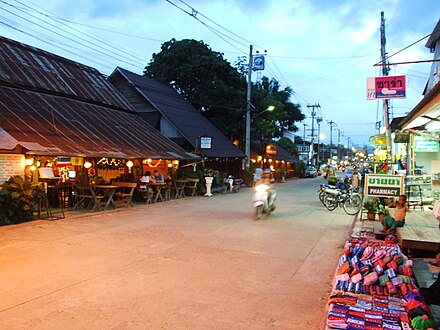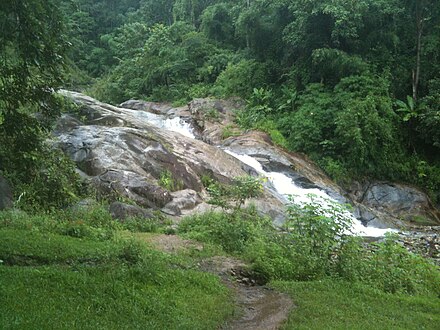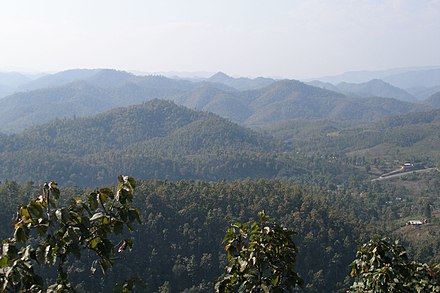Mae Hong Son Loop
Mae Hong Son Loop
The Mae Hong Son Loop is a popular route through Northern Thailand, particularly with motorcyclists and bicyclists.
Understand
Travel through the most forested province in Thailand. Also one of the most authentic, its rural beauty and cultural tapestry with influences from the Shan minority and ethnic hill tribes lend Mae Hong Son its charm. For those looking to get out of the bustling Chiang Mai, to experience authentic northern culture, the Mae Hong Son Loop is the perfect trip.
The loop is approximately 600 km long and needs at least four days to complete. It is a circular route which starts from Chiang Mai and takes you through Mae Hong Son Province ending back up at Chiang Mai. The Mae Hong Son Loop can be travelled clockwise (Chiang Mai-Mae Sariang-Mae Hong Son-Pai-Chiang Mai) or counter-clockwise (Chiang Mai-Pai-Mae Hong Son- Mae Sariang-Chiang Mai).
Prepare
As with anywhere in Thailand, sunscreen and mosquito repellent are musts. If you're planning to do the loop in the winter months (Nov-Feb) take warm clothing (light jacket, sweater, trousers) as temperatures can drop at night. For those who suffer from car sickness, some motion sickness tablets are also recommended before the start of the trip. Try to find a copy of the GT-Rider Mae Hong Son Loop map (99 baht).
Get in
Public buses connect all legs of the loop: Chiang Mai, Pai, Mae Hong Son, Mae Sariang.
Go

.jpg/440px-Temple_in_Mae_Hong_Son_(2007-02-468).jpg)


Chiang Mai to Mae Sariang
Starting from Chiang Mai and assuming a clockwise direction, Hwy 108 and 1009 will take you to the highest mountain in Thailand, Doi Inthanon. The windy road up to the peak of Doi Inthanon, 2,500 m in elevation, is also a national park. There are some remarkable waterfalls along this route including Mae Ya and Wachiratharn. You will also pass plenty of hill tribe market stands along the roadside selling local produce. Just before the summit there is a viewpoint where two impressive royal chedis stand majestically on the side of the mountain. This spot sometimes offers a good view of the valley below, however most of the time visibility is masked by the clouds due to the high altitude. Standing shrouded in this veil of clouds at the highest point in Thailand feels quite ethereal, as if you were on top of the world. Visiting Doi Inthanon is a significant detour from the road straight to Mae Sariang, and can cause the first day to be quite time constrained. Make sure you leave Chiang Mai early to fit everything in!
Back down to the base of Doi Inthanon and onto Mae Chaem, a traditional town home to a mix of hill tribes such as the Lisu, Hmong, and Lawa. From here you can either head straight to Mae Hong Son via Khun Yuam on Rte 1088 or take the off-road route to Mae Sariang.
The town of Mae Sariang retains much of the charm, culture, and character that is often missing in areas filled with tourists. There are many bars and cute hotels along the riverside. The hiking routes here are among the most authentic in the north, and are popular with travellers seeking a less commercialised trek. Surrounding the town are many sights and potential day trips such as Mae Sam Laep, the Burmese-style village on the banks of the Salawin River where a longtail boat can be hired for the day to cruise down the river, the Salawin National Park, and Mae Ngao National Park. Near the local Mae Sariang Boripat Suksa School, there is an open-air muay Thai stadium where you can take Thai boxing classes. Up the road to Mae Hong Son, there is a cultural centre with arts and crafts. You can even learn woodcarving there. Mae Sariang is a great place to rent a bicycle and explore the surrounding rice fields.
Mae Sariang to Mae Hong Son
After Mae Sariang the next destination is the capital of Mae Hong Son Province, Mae Hong Son, which is also the half-way point on the loop.
Mae Hong Son lies at the bottom of a valley among the mountain ranges that form the border of Burma and Thailand. Its remote location gives it a secluded and tranquil feel, while its proximity to Burma gives rise to the mix of people who reside there: Burmese, Shan, Thai, and hill tribe groups. This volatile blend of people and cultures gives Mae Hong Son a very distinct feel.
The centre of the town is built around Nong Jong Kham Lake and temple where you will find an array of guesthouses and restaurants. A small evening market where locals and hill tribes come to sell their wares, is also held here daily. It's a great place to pick up handicrafts and souvenirs such as woodcarvings, silverware, precious stones, and antiques.
Mae Hong Son has many Burmese and Shan-style temples. The most famous of them, and a must-see attraction, is Wat Doi Kong Mu, which sits on a hilltop and offers spectacular views of the town below. Other sights and activities include hill tribe treks, long neck Karen villages, elephant riding, bamboo rafting, and Phu Klon Country Club, a health mud spa.
The segment on Hwy 1095 from Mae Hong Son to Chiang Mai is arguably one of the most scenic drives in the north, but is not for the queasy. This mountain road is reputed to have over 1,864 curves in it. The jolts and bends on this road make it the fun fair ride of the north, but the continuously spectacular views make it worth it. The journey can be broken up by stop-off visits to Pha Sua waterfall, Tham Pla fish cave, and Tham Lod. Tham Lod, which means "coffin cave", is a favourite among tourists and is near Soppong. It is famous for its stalactite and stalagmite formations and ancient wood coffins. A bamboo raft and guide can be hired to explore the cave.
Mae Hong Son to Pai
The last destination on the loop, also worth spending an overnight, is the town of Pai, an unexpected find in a remote mountain valley. Twenty years ago the town of Pai was a few dirt roads and shops. As tourists discovered the natural beauty of the Pai River and its surrounding valley, businesses and development followed not long after, and it turned into the little backpacker settlement that it is today. Popular among hippy and artistic types, both Thai and foreign, the feel is very much new-age and has earned Pai the title of "Khao San Road of the north".
This small town is filled with bohemian cafes, restaurants, book stores, and guesthouses. During high season, from Oct-Feb, the nightlife comes alive and the tunes of Bob Marley can always be heard. During the day visitors take advantage of the hot springs, rafting, and trekking opportunities in the beautiful surrounding countryside.
If you prefer something less touristy than Pai, you could stay in Pangmapha (Soppong), which is 75 km from Mae Hong Son and 45 km before you arrive in Pai. The still traditional feel of the village, caves, jungle trekking, and many hill tribe villages make Pangmapha an attractive destination.
Pai to Chiang Mai
After a relaxing respite in Pai the loop is almost complete. Some 120 km back on Hwy 1095 will transport you out of the rugged mountains and back to the sprawl of Chiang Mai.
If you have more time, consider extending the loop by heading North to Chiang Rai, stopping overnight at Chiang Dao and Mae Salong.
See
There are various detours possible, for example:
- Mae Surin Waterfall.
- Doi Inthanon. Highest mountain of Thailand
- Pem Bok Waterfall, 19.3208456°, 98.4039468°.
- Mork Fa Waterfall, 19.1136733°, 98.7718215°.
- Pai Canyon, 19.3047°, 98.4529°.
Stay safe
Go next
Related: Mae Hong Son Province